- Bernard Preston homepage
- Our green garden
- Nine Bean Rows and a Hive for the Honeybee
Nine bean rows and a hive for the honeybee
This column on nine bean rows and a hive for the honeybee weighs some thoughts by various authors on the need for stillness in the quest for peace and finding our true selves.
I can’t say that poetry has been a big part of my existence but now in my twilight years I am finding the dreams of men like Yeats are starting to resonate with me. An overly busy reality came close to destroying him (and me too) so he made the decision to relocate to "The Lake Isle of Innisfree" and a humbler lifestyle.
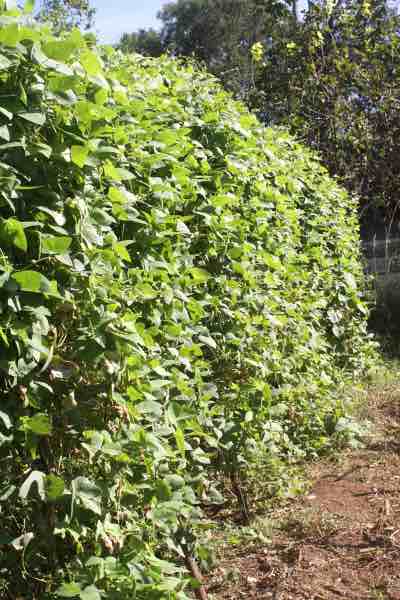 Lima-bean rows with a beehive in the background
Lima-bean rows with a beehive in the backgroundThere was no glittering mansion for Yeat's retirement but a wattle and daub cabin; nine bean rows and a hive for the honeybee. “And I shall have some peace there.”
A British doctor, William Bird has recently been awarded an MBE for his contribution to wellness. Says he, "What if a walk in a green environment could reshape brains, recalibrate the sense of time and stave off mental health conditions? If the research trends are true, doctors might soon find themselves writing prescriptions of 20 minutes of nature per day.”
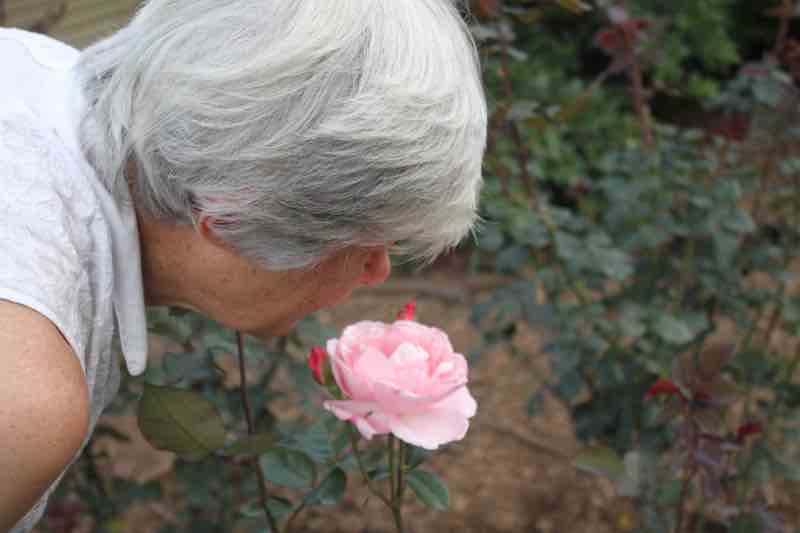 Take time to smell the roses
Take time to smell the rosesAnd an article in Clinical Medicine states that "There is increasing evidence that exposure to plants and green space and particularly to gardening, is beneficial to mental and physical health.”
Whilst he would not have known the science behind the importance of gardening and green spaces, Yeats instinctively understood that solitude, growing vegetables like beans and keeping a beehive were essential to reshape his stressed brain; the exact antithesis of social media, computers and a loaded diary.
Carl Jung the famous Swiss psychiatrist known for “becoming your true self” put it differently. “Rush and hurry are not of the Devil; they are the very Demon.” All three of these men understood the importance of stopping periodically and contemplating the meaning of life.
Even if we are not religious we have probably all heard the famous saying, “Be still and know that I am God.” Blaise Pascal the famous French scientist and mystic once wrote, “The chief problem of man is that he doesn’t know how to sit quietly alone.”
Nine bean rows
Quite why the number 9, I do not know but Yeats’ poem so touched some of my relatives that they named their weekend retreat in the foothills of the Drakensberg “Nine Beans.” It lies today buried beneath a famous resort but on a recent visit I was interested to see numerous beehives dotting the landscape.
I have written much about green beans in this column so I won’t bore you except to say we should all have legumes growing throughout the year in our gardens. They have bacteria on their roots known as Rhizobia that have the unique ability to capture nitrogen from the atmosphere, supplying the element to the plants which can then in turn synthesise it into protein; and make it available for the next crop.
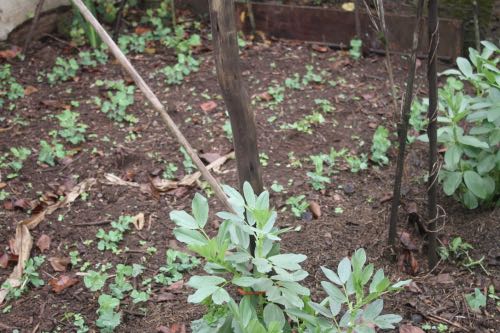 Four rows of peas and one of broad beans
Four rows of peas and one of broad beansGreen legumes have an advantage over dried beans and peas; they are much lower in a controversial substance called a lectin. This "anti-nutrient" inhibits the absorption of minerals from our food. We’ll leave that hoary chestnut for another day. They are also easier to cook; to my mind they are tastier and less chewy in any case.
Nine bean rows will I have there.
There’s just time right now in autumn to set some pea and broad bean seeds; in spring we love the climbing Witsa and limas.
In spring we will be trying a new sugar bean developed by a well known local plant breeder. Throw in the odd egg and chunks of cheese; then you can otherwise be completely self-sufficient in protein from your own green garden.
A hive for the honeybee
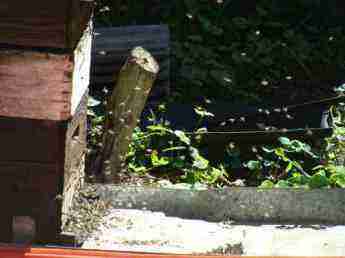
There is something very calming about watching honeybees going about their work; just don’t get too close or let them get any idea that you may be about to rob them. The autumn flow has got off to a slow start but the old-timers used to say that the gums only really start pumping after the first frost; so we live in hope.
I finish this column with my mother’s favourite poem. “If the world wearies and society ceases to satisfy, there is always the garden.”
If you too feel weary and dissatisfied with life, consider a daily prescription of twenty minutes in your backyard planting beans and greens; and do think about turning it into a “bee-loud glade.” It is so difficult to get decent honey these days and it has become very expensive.
William Yeats would approve; find his immortal poem on the net[1]. Stop and ponder, you might find your true lost self lurking down there in the garden; and some fairies too!
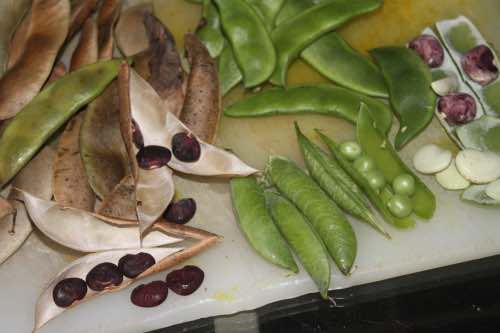 Green and dried lima beans and a few peas
Green and dried lima beans and a few peasThere is a wonderful musical sound when harvesting beans; those that have dried off sing in the breeze. The rattling sound actually helps to locate them.
Beans are a wonderful source of dietary fibre. Less than 5% of those eating a typical grocery store food are getting the required daily allowance; with terrible consequences.
Why nine bean rows?
William Butler Yeats was a Nobel Prize winner in 1923[2]; interestingly his greatest works, the poetry was written after being chosen as the first Irish laureate of literature.
Towards the end he tired of the hubbub of modern life. He sought no longer fame nor wealth but a quiet existence and contentment; and so nine bean rows and a hive for the honeybee.
Nine bean rows and a hive for the honeybee
Nine bean rows and a hive for the honeybee is from a poem by William Yeats[1].
When browsing use right click and "Open Link in New Tab" or you may get a bad gateway signal.
Newsletter
Our newsletter is entitled "create a cyan zone" at your home, preserving both yourself and Mother Earth for future generations; and the family too, of course. We promise not to spam you with daily emails promoting various products. You may get an occasional nudge to buy one of my books.
Here are the back issues.
- Lifestyle and ideal body weight
- What are ultra-processed foods?
- Investing in long-term health
- Diseases from plastic exposure
- Intensive lifestyle management for obesity has limited value
- A world largely devoid of Parkinson's Disease
- The impact of friendly bacteria in the tum on the prevention of cancer
- There's a hole in the bucket
- Everyone is talking about weight loss drugs
- Pull the sweet tooth
- If you suffer from heartburn plant a susu
- Refined maize meal and stunting
- Should agriculture and industry get priority for water and electricity?
- Nature is calling
- Mill your own flour
- Bake your own sourdough bread
- Microplastics from our water
- Alternative types of water storage
- Wear your clothes out
- Comfort foods
- Create a bee-friendly environment
- Go to bed slightly hungry
- Keep bees
- Blue zone folk are religious
- Reduce plastic waste
- Family is important
- What can go in compost?
- Grow broad beans for longevity
- Harvest and store sunshine
- Blue zone exercise
- Harvest and store your rainwater
- Create a cyan zone at your home
Did you find this page interesting? How about forwarding it to a friendly book or food junkie? Better still, a social media tick would help.
- Bernard Preston homepage
- Our green garden
- Nine Bean Rows and a Hive for the Honeybee
Address:
56 Groenekloof Rd,
Hilton, KZN
South Africa
Website:
https://www.bernard-preston.com